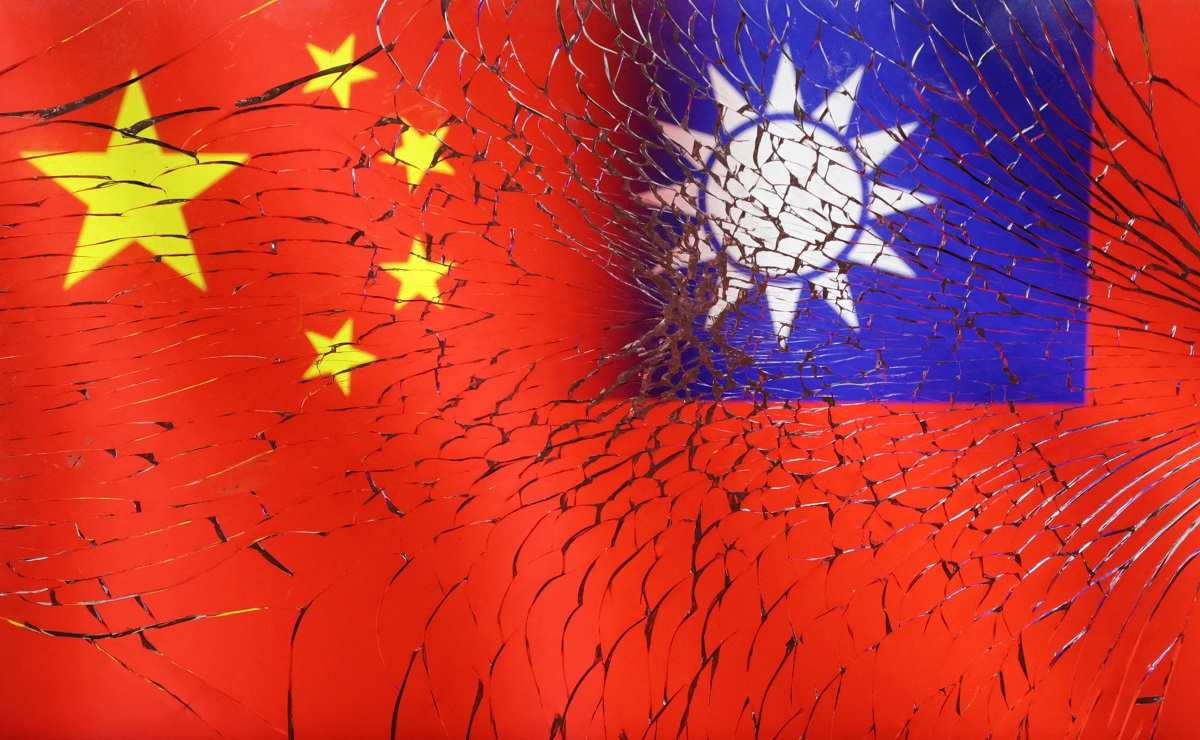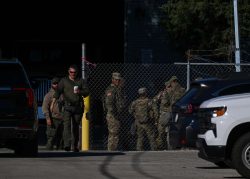
Chinese and Taiwanese flags are seen through broken glass in this illustration taken, April 11, 2023.
12:41 JST, April 12, 2023
TAIPEI, Taiwan – China’s newest aircraft carrier has for the first time practiced attacking Taiwan from the island’s east coast, demonstrating Beijing’s growing determination to project power beyond the Taiwan Strait and far into the Pacific Ocean, an area traditionally dominated by the United States and its regional allies.
Chinese saber-rattling in the Taiwan Strait, which is just 80 miles wide at its narrowest point, has become commonplace as the Communist Party under Xi Jinping becomes increasingly vehement about its intent to take control of the self-governed democracy.
But the three days of military exercises around Taiwan that concluded on Monday marked a change: They focused on dominating the air and sea in the western Pacific by simulating a carrier-based strike from the far side of the island, rather than the usual approach from the Taiwan Strait that separates the island from China.
“If the People’s Liberation Army can strategically occupy this region, it will make it difficult for the United States to intervene or support Taiwan,” said Lin Ying-yu, a professor of international relations at Tamkang University in Taiwan.
A record 91 Chinese warplanes flew near Taiwanese airspace on the final day of exercises, Taiwan’s Defense Ministry reported on Tuesday. Fifteen of those incursions were J-15 fighter jets launched from the Shandong, China’s newest aircraft carrier.
Those newly demonstrated capabilities pose a challenge to Taiwan’s defensive strategy, which traditionally has focused on attacks from across the Taiwan Strait. They could also deepen concern in Japan, the Philippines and other U.S. allies and partners about the creep of Chinese military aggression deeper into the Pacific.
Taipei previously assumed that airfields on its east coast could operate as backup if China attacked west coast installations, but China’s growing ability to control the sea and air on the far side of Taiwan means that plan might need to be revised, Lin said.
Focusing drills on the western Pacific was also intended to warn Washington against coming to Taipei’s defense if China attacks, he said. The United States has a large military base on the island of Guam in the western Pacific, a forward position in the region.
China made no secret that it intended to send a message to the United States and its allies by expanding into the western Pacific.
Zhao Xiaozhou, a researcher at the People’s Liberation Army’s Academy of Military Science, described the exercises as being designed to first establish control of the air, sea and communication, simulate an attack on Taiwan, then practice deterring foreign support for Taiwan.
Chinese firepower or warships should “all extend to the east of Taiwan” and toward the Pacific Ocean, which will “de facto prevent the intervention of outside forces,” he told state broadcaster CGTN.
Taiwan’s Foreign Ministry accused China of attempting to unilaterally change the unspoken rules that have for decades prevented simmering cross-strait tensions erupting into open military conflict.
“It’s abundantly clear that the drills are bellicose militarism and an attempt to change the status quo and establish new red lines,” it said in a statement on Monday.
Even after drills had officially ended, Chinese warplanes continued to fly close to Taiwanese airspace on Tuesday, piling pressure on Taiwan’s overworked air force. As of 11 a.m. local time, 14 aircraft had crossed the median line of the Taiwan Strait, an unofficial boundary down the middle of the waterway, Taiwan’s Defense Ministry reported.
The show of force was in retaliation for Taiwanese President Tsai Ing-wen meeting with House Speaker Kevin McCarthy (R-Calif.) in Los Angeles last week. It underscored the Chinese Communist Party’s deep dislike of American moves to strengthen its unofficial relationship with Taiwan, which Beijing claims is part of its territory.
The self-governing island democracy’s 23 million residents have shown little interest in submitting to rule by Beijing, but that hasn’t stopped China from regularly threatening to take control by force.
Tsai, responding to the drills on Monday, said China’s behavior was “not the approach of a responsible regional power.”
Representing Taiwan overseas, including in the United States, “is not only commonplace but also the common expectation of the Taiwanese people,” she wrote on Facebook. “But China uses this to cause instability in Taiwan and the region.”
Taiwanese defense experts often warn of Beijing’s gradual effort to gain ground in the cross-strait military standoff by adopting “gray zone” tactics that encroach on the status quo while stopping short of a direct confrontation.
Beijing particularly likes to try out new tactics or deploy its latest technology during displays of force after perceived slights by Taiwan.
When Nancy Pelosi, then the House speaker, visited Taiwan in August, China responded by carrying out a simulated blockade of Taiwan as well as firing missiles high over Taipei into waters east of the island. Five of those projectiles flew so far that they landed in Japan’s exclusive economic zone.
Japan was again dragged into the latest drills, scrambling jets in response to Chinese sorties from the Shandong that took place near Miyako Island, part of the Okinawa island chain. On Tuesday, Japanese Defense Minister Yasukazu Hamada described the drills as “intimidating training” to dominate air and sea around Taiwan.
The growing frequency and scale of China’s operations – as well as American efforts to work with allies to counter Beijing – have caused a spike in military activity throughout the region.
The Philippines and the United States have expanded the scale of annual “Balikatan” exercises, which began on Tuesday, to more than 17,000 troops. This month, the Pentagon released details of additional U.S. forces that will regularly visit Philippine military outposts to better respond to regional challenges.
An American guided-missile destroyer, the USS Milius, conducted a freedom-of-navigation operation in the South China Sea on Monday, coming within 12 nautical miles of Mischief Reef in the Spratly Islands to challenge China’s extensive territorial claims in the disputed waters. Beijing called the operation “illegal.”
"News Services" POPULAR ARTICLE
-

American Playwright Jeremy O. Harris Arrested in Japan on Alleged Drug Smuggling
-

Japan’s Nikkei Stock Average as JGB Yields, Yen Rise on Rate-Hike Bets
-

Japan’s Nikkei Stock Average Licks Wounds after Selloff Sparked by BOJ Hike Bets (UPDATE 1)
-

Japan’s Nikkei Stock Average Buoyed by Stable Yen; SoftBank’s Slide Caps Gains (UPDATE 1)
-

Japanese Bond Yields Zoom, Stocks Slide as Rate Hike Looms
JN ACCESS RANKING
-

Tokyo Economic Security Forum to Hold Inaugural Meeting Amid Tense Global Environment
-

Keidanren Chairman Yoshinobu Tsutsui Visits Kashiwazaki-Kariwa Nuclear Power Plant; Inspects New Emergency Safety System
-

Imports of Rare Earths from China Facing Delays, May Be Caused by Deterioration of Japan-China Relations
-

University of Tokyo Professor Discusses Japanese Economic Security in Interview Ahead of Forum
-

Japan Pulls out of Vietnam Nuclear Project, Complicating Hanoi’s Power Plans
























